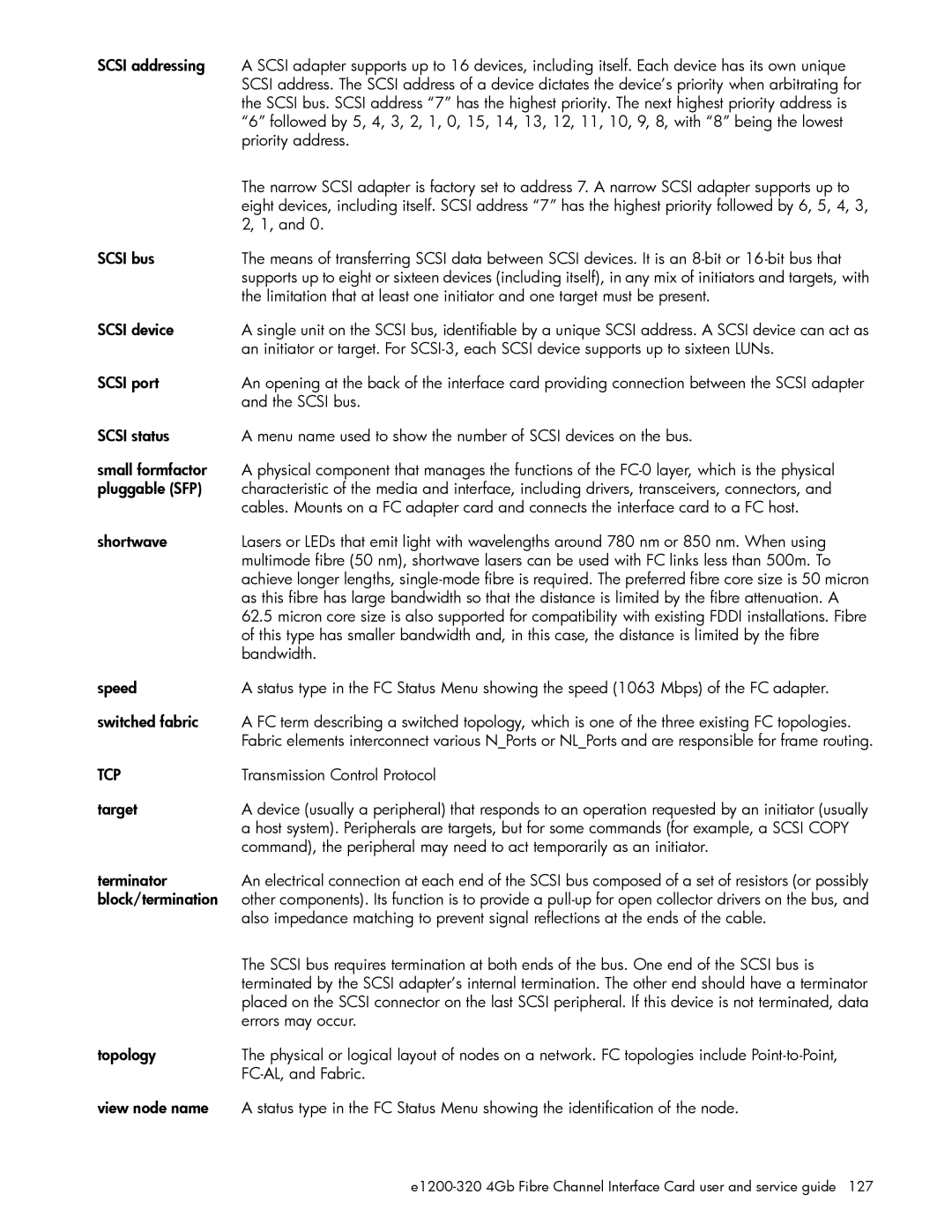SCSI addressing | A SCSI adapter supports up to 16 devices, including itself. Each device has its own unique |
| SCSI address. The SCSI address of a device dictates the device’s priority when arbitrating for |
| the SCSI bus. SCSI address “7” has the highest priority. The next highest priority address is |
| “6” followed by 5, 4, 3, 2, 1, 0, 15, 14, 13, 12, 11, 10, 9, 8, with “8” being the lowest |
| priority address. |
| The narrow SCSI adapter is factory set to address 7. A narrow SCSI adapter supports up to |
| eight devices, including itself. SCSI address “7” has the highest priority followed by 6, 5, 4, 3, |
| 2, 1, and 0. |
SCSI bus | The means of transferring SCSI data between SCSI devices. It is an |
| supports up to eight or sixteen devices (including itself), in any mix of initiators and targets, with |
| the limitation that at least one initiator and one target must be present. |
SCSI device | A single unit on the SCSI bus, identifiable by a unique SCSI address. A SCSI device can act as |
| an initiator or target. For |
SCSI port | An opening at the back of the interface card providing connection between the SCSI adapter |
| and the SCSI bus. |
SCSI status | A menu name used to show the number of SCSI devices on the bus. |
small formfactor | A physical component that manages the functions of the |
pluggable (SFP) | characteristic of the media and interface, including drivers, transceivers, connectors, and |
| cables. Mounts on a FC adapter card and connects the interface card to a FC host. |
shortwave | Lasers or LEDs that emit light with wavelengths around 780 nm or 850 nm. When using |
| multimode fibre (50 nm), shortwave lasers can be used with FC links less than 500m. To |
| achieve longer lengths, |
| as this fibre has large bandwidth so that the distance is limited by the fibre attenuation. A |
| 62.5 micron core size is also supported for compatibility with existing FDDI installations. Fibre |
| of this type has smaller bandwidth and, in this case, the distance is limited by the fibre |
| bandwidth. |
speed | A status type in the FC Status Menu showing the speed (1063 Mbps) of the FC adapter. |
switched fabric | A FC term describing a switched topology, which is one of the three existing FC topologies. |
| Fabric elements interconnect various N_Ports or NL_Ports and are responsible for frame routing. |
TCP | Transmission Control Protocol |
target | A device (usually a peripheral) that responds to an operation requested by an initiator (usually |
| a host system). Peripherals are targets, but for some commands (for example, a SCSI COPY |
| command), the peripheral may need to act temporarily as an initiator. |
terminator | An electrical connection at each end of the SCSI bus composed of a set of resistors (or possibly |
block/termination | other components). Its function is to provide a |
| also impedance matching to prevent signal reflections at the ends of the cable. |
| The SCSI bus requires termination at both ends of the bus. One end of the SCSI bus is |
| terminated by the SCSI adapter’s internal termination. The other end should have a terminator |
| placed on the SCSI connector on the last SCSI peripheral. If this device is not terminated, data |
| errors may occur. |
topology | The physical or logical layout of nodes on a network. FC topologies include |
| |
view node name | A status type in the FC Status Menu showing the identification of the node. |
Page 127
Image 127
